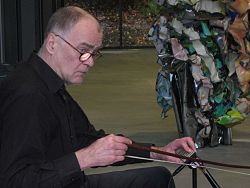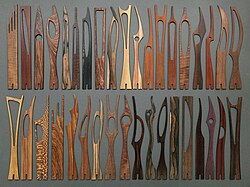No edit summary |
No edit summary |
||
| Line 11: | Line 11: | ||
== List of known daxophonists and discography == |
== List of known daxophonists and discography == |
||
*[[Daniel Fishkin]]<ref>[http://www.wesleyan.edu/cfa/events/2014/10-2014/10282014daniel-fishkin-transcriptions.html/ Daniel Fishkin: Transcriptions]</ref> |
*[[Daniel Fishkin]]<ref>[http://www.wesleyan.edu/cfa/events/2014/10-2014/10282014daniel-fishkin-transcriptions.html/ Daniel Fishkin: Transcriptions]</ref> |
||
**[https://archive.org/details/dandelionfiction-youreastrongone/ You're A Strong One] |
|||
*[[Michael Hearst]] (born 1972) |
*[[Michael Hearst]] (born 1972) |
||
**Michael Hearst Songs For Unusual Creatures (2012) (Urban Geek Records) |
**[http://www.unusualcreatures.com/ Michael Hearst Songs For Unusual Creatures] (2012) (Urban Geek Records) |
||
*[[Hans Reichel]] (1949-2011) |
*[[Hans Reichel]] (1949-2011) |
||
**Shanghaied on Tor Road: The World's 1st Operetta Performed on Nothing but the Daxophone (1992, FMP CD 46) |
**Shanghaied on Tor Road: The World's 1st Operetta Performed on Nothing but the Daxophone (1992, FMP CD 46) ([https://www.youtube.com/watch?v=Vb23PNogJ0M/ excerpt]) |
||
**Lower Lurum (1993/1994, Rastascan BRD 016) |
**Lower Lurum (1993/1994, Rastascan BRD 016) ([https://www.youtube.com/watch?v=6mDYAJICd5o/ excerpt]) |
||
**Yuxo: A New Daxophone Operetta (2002, A/L/L 003) |
**Yuxo: A New Daxophone Operetta (2002, A/L/L 003) ([https://www.youtube.com/watch?v=Vb23PNogJ0M/ excerpt]) |
||
*[[Mark Stewart (guitarist)|Mark Stewart]] |
*[[Mark Stewart (guitarist)|Mark Stewart]] ([https://www.youtube.com/watch?v=F0IZxu3OJt8/ video of Mark Stewart playing the daxophone]) |
||
*[[Kazuhisa Uchihashi]] |
*[[Kazuhisa Uchihashi]] |
||
Revision as of 22:18, 28 July 2015

The daxophone, invented by Hans Reichel (1949-2011) and first played in 1987, is an experimental musical instrument of the friction idiophones category.[1] It consists of a thin wooden blade, approximately 330 mm in length, 30 mm in width, and 5 mm in height, fixed in a wooden block (often attached to a tripod, but also clamped to a table top), which holds one or more contact microphones.[1] Normally, it is played by bowing the free end, but it can also be struck or plucked, which propagates sound in the same way a ruler halfway off a table does.[2] These vibrations then continue to the wooden-block base, which in turn is amplified by the contact microphone(s) therein. A wide range of voice-like timbres can be produced, depending on the shape of the instrument, the type of wood, where it is bowed, and where along its length it is stopped with a separate block of wood (fretted on one side) called the "dax", which is approximately 150 mm long and 50 mm tall, with a custom width tailored to the player's hands.[1] One side of the dax is logarithmically fretted, though the frets are too far apart to play every note in the chromatic scale, which is why the unfretted side is more frequently used (shielded with a sheet of cardboard to mellow the sound). These sounds are notable for their comical, often human sounds.[3]

Reichel has documented the construction of the instrument in a way that a skilled woodworker could build his own. Plans are downloadable from his website, with a collection of proven shapes for the blade delivered in the file format of a font, thus playing on Reichel's other profession as a typeface designer.
Etymology
The dax in daxophone is derived from the German word dachs, meaning "badger" and a referencing the many animal sounds that the daxophone is capable of generating, changed to dax so that the instrument name echoes Adolphe Sax's saxophone.[1]
List of known daxophonists and discography
- Daniel Fishkin[4]
- Michael Hearst (born 1972)
- Michael Hearst Songs For Unusual Creatures (2012) (Urban Geek Records)
- Hans Reichel (1949-2011)
- Mark Stewart (video of Mark Stewart playing the daxophone)
- Kazuhisa Uchihashi
References
External links
- http://oddstruments.com/the-daxophone-and-its-singing-alphabet-of-forked-tongues/
- Some information on the daxophone by Hans Reichel (19 MB)
- Hans Reichel's FMP releases
- Reichel's step-by-step construction of a daxophone
- EFI daxophone information page
- Daxophone video
- Album by American daxophonist Daniel Fishkin, featuring some live-looped daxophone recordings